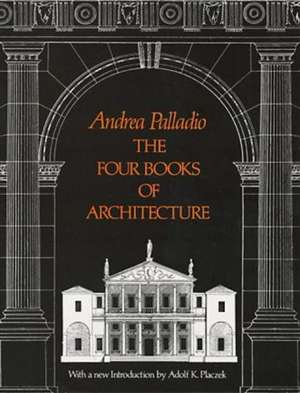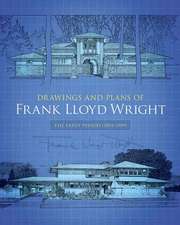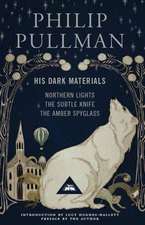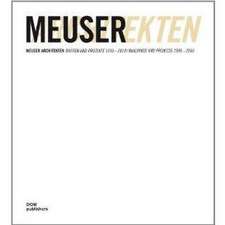The Four Books of Architecture: Dover Pictorial Archives
Autor Andrea Palladio Editat de Isaac Ware, Adolpf K. Placzeken Limba Engleză Paperback – 31 mai 1965
Andrea Palladio (1508-1580) was one of the most celebrated architects of the Renaissance, so important that the term Palladian has been applied to a particular style of architecture that adheres to classical concepts. The wide spread of Palladianism was due partly to the private and public buildings he constructed in Italy, the designs of which were copied throughout Europe. But of even greater consequence was his remarkable magnum opus, "I Quattro Libri dell'Architettura"; translated into every major Western European language in the two centuries following its publication in 1570, it has been one of the most influential books in the history of architecture.
"The Four Books of Architecture" offers a compendium of Palladio's art and of the ancient Roman structures that inspired him. The First Book is devoted to building materials and techniques and the five orders of architecture: Tuscan, Doric, Ionic, Corinthian, and Composite. Palladio indicates the characteristic features of each order and supplies illustrations of various architectural details. The Second Book deals with private houses and mansions, almost all of Palladio's own design. Shown and described are many of his villas in and near Venice and Vicenza (including the famous Villa Capra, or "The Rotunda," the Thiene Palace, and the Valmarana Palace). Each plate gives a front view drawing of the building and the general floor plan. The Third Book is concerned with streets, bridges, piazzas, and basilicas, most of which are of ancient Roman origin. In the Fourth Book, Palladio reproduces the designs of a number of ancient Roman temples. Plates 51 to 60 are plans and architectural sketches of the Pantheon.
In all, the text is illustrated by over 200 magnificently engraved plates, showing edifices, either of Palladio's own design or reconstructed (in these drawings) by him from classical ruins and contemporary accounts.
All the original plates are reproduced in this new single-volume edition in full size and in clear, sharp detail. This is a republication of the Isaac Ware English edition of 1738. Faithful and accurate in the translation and in its reproduction of the exquisite original engravings, it has long been a rare, sought-after work. This edition makes The Four Books available for the first time in more than 200 years to the English-speaking public.
| Toate formatele și edițiile | Preț | Express |
|---|---|---|
| Paperback (2) | 151.31 lei 43-57 zile | +90.35 lei 6-12 zile |
| Dover Publications – 31 mai 1965 | 217.14 lei 22-29 zile | +90.35 lei 6-12 zile |
| Digireads.com – 5 iul 2021 | 151.31 lei 43-57 zile |
Din seria Dover Pictorial Archives
-
 Preț: 29.93 lei
Preț: 29.93 lei -
 Preț: 73.78 lei
Preț: 73.78 lei - 14%
 Preț: 108.51 lei
Preț: 108.51 lei - 14%
 Preț: 33.18 lei
Preț: 33.18 lei -
 Preț: 57.87 lei
Preț: 57.87 lei -
 Preț: 50.68 lei
Preț: 50.68 lei -
 Preț: 109.26 lei
Preț: 109.26 lei -
 Preț: 122.68 lei
Preț: 122.68 lei -
 Preț: 114.23 lei
Preț: 114.23 lei -
 Preț: 174.03 lei
Preț: 174.03 lei - 16%
 Preț: 67.45 lei
Preț: 67.45 lei - 17%
 Preț: 75.02 lei
Preț: 75.02 lei - 11%
 Preț: 23.82 lei
Preț: 23.82 lei - 16%
 Preț: 197.88 lei
Preț: 197.88 lei - 15%
 Preț: 68.33 lei
Preț: 68.33 lei - 15%
 Preț: 46.24 lei
Preț: 46.24 lei -
 Preț: 62.44 lei
Preț: 62.44 lei -
 Preț: 71.14 lei
Preț: 71.14 lei - 16%
 Preț: 59.20 lei
Preț: 59.20 lei -
 Preț: 69.27 lei
Preț: 69.27 lei -
 Preț: 29.75 lei
Preț: 29.75 lei - 15%
 Preț: 81.56 lei
Preț: 81.56 lei - 14%
 Preț: 83.25 lei
Preț: 83.25 lei - 19%
 Preț: 164.91 lei
Preț: 164.91 lei - 14%
 Preț: 85.70 lei
Preț: 85.70 lei - 15%
 Preț: 60.27 lei
Preț: 60.27 lei -
 Preț: 91.55 lei
Preț: 91.55 lei - 15%
 Preț: 79.12 lei
Preț: 79.12 lei - 14%
 Preț: 69.22 lei
Preț: 69.22 lei - 15%
 Preț: 79.75 lei
Preț: 79.75 lei - 14%
 Preț: 83.71 lei
Preț: 83.71 lei -
 Preț: 92.98 lei
Preț: 92.98 lei - 16%
 Preț: 45.53 lei
Preț: 45.53 lei -
 Preț: 31.89 lei
Preț: 31.89 lei -
 Preț: 62.25 lei
Preț: 62.25 lei - 26%
 Preț: 135.75 lei
Preț: 135.75 lei -
 Preț: 77.52 lei
Preț: 77.52 lei - 15%
 Preț: 40.89 lei
Preț: 40.89 lei - 16%
 Preț: 77.34 lei
Preț: 77.34 lei - 15%
 Preț: 92.79 lei
Preț: 92.79 lei - 16%
 Preț: 123.27 lei
Preț: 123.27 lei -
 Preț: 107.22 lei
Preț: 107.22 lei - 15%
 Preț: 67.80 lei
Preț: 67.80 lei -
 Preț: 111.72 lei
Preț: 111.72 lei - 17%
 Preț: 65.68 lei
Preț: 65.68 lei - 16%
 Preț: 67.45 lei
Preț: 67.45 lei - 14%
 Preț: 69.75 lei
Preț: 69.75 lei -
 Preț: 99.80 lei
Preț: 99.80 lei - 16%
 Preț: 110.89 lei
Preț: 110.89 lei
Preț: 217.14 lei
Preț vechi: 263.37 lei
-18% Nou
41.55€ • 43.14$ • 34.65£
Carte disponibilă
Livrare economică 03-10 martie
Livrare express 15-21 februarie pentru 100.34 lei
Specificații
ISBN-10: 0486213080
Pagini: 352
Ilustrații: 212ill.
Dimensiuni: 239 x 310 x 23 mm
Greutate: 0.89 kg
Ediția:Dover.
Editura: Dover Publications
Seria Dover Pictorial Archives
Locul publicării:United States
Descriere
-- Joseph Rykwert, Paul Philippe Cret Professor of Architecture, University of Pennsylvania The Renaissance architect Andrea Palladio was one of the most influential figures that the field of architecture has ever produced. For classical architects, the term Palladian stands for a vocabulary of architectural forms embodying perfection and beauty. Of even greater significance than Palladio's buildings is his treatise "I quattro libri dell'architettura" (The Four Books On Architecture), the most successful architectural treatise of the Renaissance and one of the two or three most important books in the literature of architecture. First published in Italian in 1570, it has been translated into every major Western language. This is the first English translation of Palladio in over 250 years, making it the only translation available in modern English. Until now, English-language readers have had to rely mostly on a facsimile of Isaac Ware's 1738 translation and the eighteenth-century engravings prepared for that text. This new translation by Robert Tavernor and Richard Schofield contains Palladio's original woodcuts, reproduced in facsimile and positioned correctly, adjacent to the text. The book also contains a glossary that explains technical terms in their original context, a bibliography of recent Palladio research, and an introduction toPalladio and his times.
The First Book discusses building materials and techniques, as well as the five orders of architecture: Tuscan, Doric, Ionic, Corinthian, and Composite. Palladio describes the characteristics of each order and illustrates them. The Second Book discusses private town houses and country estates, almost all designed by Palladio. The Third Book discusses streets, bridges, piazzas, and basilicas, most of ancient Roman origin. The Fourth Book discusses ancient Roman temples, including the Pantheon.
Textul de pe ultima copertă
Andrea Palladio (1508-1580) was one of the most celebrated architects of the Renaissance, so important that the term Palladian has been applied to a particular style of architecture that adheres to classical concepts. The wide spread of Palladianism was due partly to the private and public buildings he constructed in Italy, the designs of which were copied throughout Europe. But of even greater consequence was his remarkable magnum opus, "I Quattro Libri dell'Architettura"; translated into every major Western European language in the two centuries following its publication in 1570, it has been one of the most influential books in the history of architecture.
"The Four Books of Architecture" offers a compendium of Palladio's art and of the ancient Roman structures that inspired him. The First Book is devoted to building materials and techniques and the five orders of architecture: Tuscan, Doric, Ionic, Corinthian, and Composite. Palladio indicates the characteristic features of each order and supplies illustrations of various architectural details. The Second Book deals with private houses and mansions, almost all of Palladio's own design. Shown and described are many of his villas in and near Venice and Vicenza (including the famous Villa Capra, or "The Rotunda," the Thiene Palace, and the Valmarana Palace). Each plate gives a front view drawing of the building and the general floor plan. The Third Book is concerned with streets, bridges, piazzas, and basilicas, most of which are of ancient Roman origin. In the Fourth Book, Palladio reproduces the designs of a number of ancient Roman temples. Plates 51 to 60 are plans and architectural sketches of the Pantheon.
In all, the text is illustrated by over 200 magnificently engraved plates, showing edifices, either of Palladio's own design or reconstructed (in these drawings) by him from classical ruins and contemporary accounts.
All the original plates are reproduced in this new single-volume edition in full size and in clear, sharp detail. This is a republication of the Isaac Ware English edition of 1738. Faithful and accurate in the translation and in its reproduction of the exquisite original engravings, it has long been a rare, sought-after work. This edition makes The Four Books available for the first time in more than 200 years to the English-speaking public.













